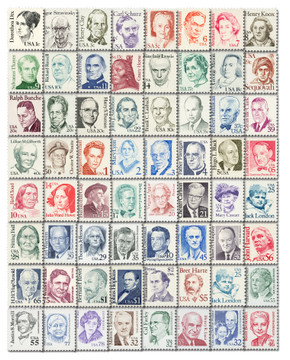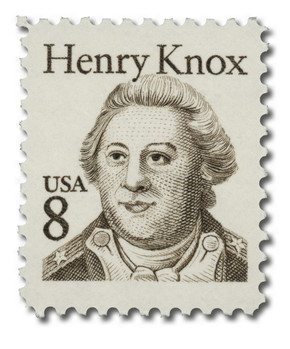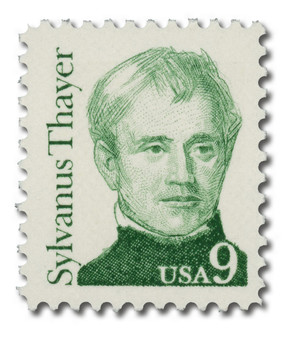
US #2942
1998 Mary Breckinridge
- 62nd stamp in Great Americans Series
- Honors founder of Frontier Nursing Service
- Issue for upcoming rate change
Category of Stamp: Definitive
Set: Great Americans
Value: 77¢, three-ounce letter rate
First Day of Issue: November 9, 1998
First Day City: Troy, New York
Quantity Issued: 110,000,000
Printed by: Banknote Corporation of America
Printing Method/Format: Engraved. Panes of 20 from printing plates of 240 (12 across, 20 down)
Perforations: die cut (11.7 X 11.5)
Color: Blue
Reason the stamp was issued: The Mary Breckinridge stamp was issued to cover the three-ounce rate that was scheduled to change on January 10, 1999. It honors the founder of the Frontier Nursing Service, which provided medical care to thousands of rural Americans.
About the stamp design: Chris Calle drew the pencil portrait of Mary Breckinridge used for this stamp, as well as many others in the Great Americans series. He based his portrait on a photo of Mary as an older woman.
First Day City: The First Day of Issue ceremony for this stamp took place in Troy, New York, along with the dedication of two H-rate makeup stamps, two Uncle Sam stamps, and a Priority Mail stamp.
Unusual thing about this stamp: Mary Breckinridge had been approved as a subject of a US stamp for over a decade before this stamp was issued. The initial sketch for the stamp showed Breckinridge as a young woman in a fashionable hat. Those who knew Mary well, preferred representing her as an older woman without a hat.
About the Great Americans Series:
The Great Americans Series was created to replace the Americana Series. The new series would be characterized by a standard definitive size, simple design, and monochromatic colors.
This simple design included a portrait, “USA,” the denomination, the person’s name, and in some cases, their occupation or reason for recognition. The first stamp in the new series was issued on December 27, 1980. It honored Sequoyah and fulfilled the new international postcard rate that would go into effect in January 1981.
The Great Americans Series would honor a wider range of people than the previous Prominent Americans and Liberty Series. While those series mainly honored presidents and politicians, the Great Americans Series featured people from many fields and ethnicities. They were individuals who were leaders in education, the military, literature, the arts, and human and civil rights. Plus, while the previous series only honored a few women, the Great Americans featured 15 women. This was also the first definitive series to honor Native Americans, with five stamps.
The Bureau of Engraving and Printing (BEP) produced most of the stamps, but private firms printed some. Several stamps saw multiple printings. The result was many different varieties, with tagging being the key to understanding them. Though there were also differences in perforations, gum, paper, and ink color.
The final stamp in the series was issued on July 17, 1999, honoring Justin S. Morrill. Spanning 20 years, the Great Americans was the longest-running US definitive series. It was also the largest series of face-different stamps, with a total of 63.
History the stamp represents:
Nurse midwife Mary Carson Breckinridge was born on February 17, 1881, in Memphis, Tennessee.
Nurse midwife Mary Carson Breckinridge was born on February 17, 1881, in Memphis, Tennessee. She was the daughter of Congressman Clifton Breckinridge and granddaughter of US Vice President John C. Breckinridge. When her father was appointed US Minister to Russia in 1894, the family moved there and she received some of her education there from private tutors.
The family returned to the US in 1897. Breckinridge’s mother disapproved of her cousin’s decision to go to college and insisted that her daughter get married and follow a more traditional path. Breckinridge got married in 1904, but her husband died two years later. She then joined the nursing program at New York’s St. Luke Hospital, earning her degree in 1910.
Breckinridge went on to join the American Committee for Devastated France and served as the volunteer director of Child Hygiene and District Nursing. While working in Europe, Breckinridge met French and British nurse midwives. She realized that American nurses should receive similar training to help rural American families.
Breckinridge visited remote European towns to see how they handled health care and found inspiration to bring back home. She also studied at the British Hospital for Mothers and Babies and received her certification from the Central Midwives Board.
Breckinridge returned to the US in 1925 and founded the Kentucky Committee for Mothers and Babies, which later became known as the Frontier Nursing Service. It was the first such service in the US to employ nurses that were certified midwives. Breckinridge’s father as well as two midwives she met in London joined the operation, which delivered its first baby in September 1925. Breckinridge’s nurses would travel by horse anytime day or night to deliver babies.
The Frontier Nursing Service grew quickly, opening nine outpost nursing centers over the years. Initially, Breckinridge sent nurses to Britain for midwifery training. However, with the outbreak of World War II that was no longer feasible, so she quickly created the Frontier Graduate School of Midwifery in 1939.
During the Frontier Nursing Service’s first 30 years in operation, it had better statistics than the national average in terms of maternal mortality rates and low baby birth weights. By 1959, the service had assisted in over 10,000 births.
Breckinridge worked with the Frontier Nursing Service until her death on May 16, 1965. The Frontier Nursing Service is still in operation today, overseeing six healthcare clinics.
US #2942
1998 Mary Breckinridge
- 62nd stamp in Great Americans Series
- Honors founder of Frontier Nursing Service
- Issue for upcoming rate change
Category of Stamp: Definitive
Set: Great Americans
Value: 77¢, three-ounce letter rate
First Day of Issue: November 9, 1998
First Day City: Troy, New York
Quantity Issued: 110,000,000
Printed by: Banknote Corporation of America
Printing Method/Format: Engraved. Panes of 20 from printing plates of 240 (12 across, 20 down)
Perforations: die cut (11.7 X 11.5)
Color: Blue
Reason the stamp was issued: The Mary Breckinridge stamp was issued to cover the three-ounce rate that was scheduled to change on January 10, 1999. It honors the founder of the Frontier Nursing Service, which provided medical care to thousands of rural Americans.
About the stamp design: Chris Calle drew the pencil portrait of Mary Breckinridge used for this stamp, as well as many others in the Great Americans series. He based his portrait on a photo of Mary as an older woman.
First Day City: The First Day of Issue ceremony for this stamp took place in Troy, New York, along with the dedication of two H-rate makeup stamps, two Uncle Sam stamps, and a Priority Mail stamp.
Unusual thing about this stamp: Mary Breckinridge had been approved as a subject of a US stamp for over a decade before this stamp was issued. The initial sketch for the stamp showed Breckinridge as a young woman in a fashionable hat. Those who knew Mary well, preferred representing her as an older woman without a hat.
About the Great Americans Series:
The Great Americans Series was created to replace the Americana Series. The new series would be characterized by a standard definitive size, simple design, and monochromatic colors.
This simple design included a portrait, “USA,” the denomination, the person’s name, and in some cases, their occupation or reason for recognition. The first stamp in the new series was issued on December 27, 1980. It honored Sequoyah and fulfilled the new international postcard rate that would go into effect in January 1981.
The Great Americans Series would honor a wider range of people than the previous Prominent Americans and Liberty Series. While those series mainly honored presidents and politicians, the Great Americans Series featured people from many fields and ethnicities. They were individuals who were leaders in education, the military, literature, the arts, and human and civil rights. Plus, while the previous series only honored a few women, the Great Americans featured 15 women. This was also the first definitive series to honor Native Americans, with five stamps.
The Bureau of Engraving and Printing (BEP) produced most of the stamps, but private firms printed some. Several stamps saw multiple printings. The result was many different varieties, with tagging being the key to understanding them. Though there were also differences in perforations, gum, paper, and ink color.
The final stamp in the series was issued on July 17, 1999, honoring Justin S. Morrill. Spanning 20 years, the Great Americans was the longest-running US definitive series. It was also the largest series of face-different stamps, with a total of 63.
History the stamp represents:
Nurse midwife Mary Carson Breckinridge was born on February 17, 1881, in Memphis, Tennessee.
Nurse midwife Mary Carson Breckinridge was born on February 17, 1881, in Memphis, Tennessee. She was the daughter of Congressman Clifton Breckinridge and granddaughter of US Vice President John C. Breckinridge. When her father was appointed US Minister to Russia in 1894, the family moved there and she received some of her education there from private tutors.
The family returned to the US in 1897. Breckinridge’s mother disapproved of her cousin’s decision to go to college and insisted that her daughter get married and follow a more traditional path. Breckinridge got married in 1904, but her husband died two years later. She then joined the nursing program at New York’s St. Luke Hospital, earning her degree in 1910.
Breckinridge went on to join the American Committee for Devastated France and served as the volunteer director of Child Hygiene and District Nursing. While working in Europe, Breckinridge met French and British nurse midwives. She realized that American nurses should receive similar training to help rural American families.
Breckinridge visited remote European towns to see how they handled health care and found inspiration to bring back home. She also studied at the British Hospital for Mothers and Babies and received her certification from the Central Midwives Board.
Breckinridge returned to the US in 1925 and founded the Kentucky Committee for Mothers and Babies, which later became known as the Frontier Nursing Service. It was the first such service in the US to employ nurses that were certified midwives. Breckinridge’s father as well as two midwives she met in London joined the operation, which delivered its first baby in September 1925. Breckinridge’s nurses would travel by horse anytime day or night to deliver babies.
The Frontier Nursing Service grew quickly, opening nine outpost nursing centers over the years. Initially, Breckinridge sent nurses to Britain for midwifery training. However, with the outbreak of World War II that was no longer feasible, so she quickly created the Frontier Graduate School of Midwifery in 1939.
During the Frontier Nursing Service’s first 30 years in operation, it had better statistics than the national average in terms of maternal mortality rates and low baby birth weights. By 1959, the service had assisted in over 10,000 births.
Breckinridge worked with the Frontier Nursing Service until her death on May 16, 1965. The Frontier Nursing Service is still in operation today, overseeing six healthcare clinics.















